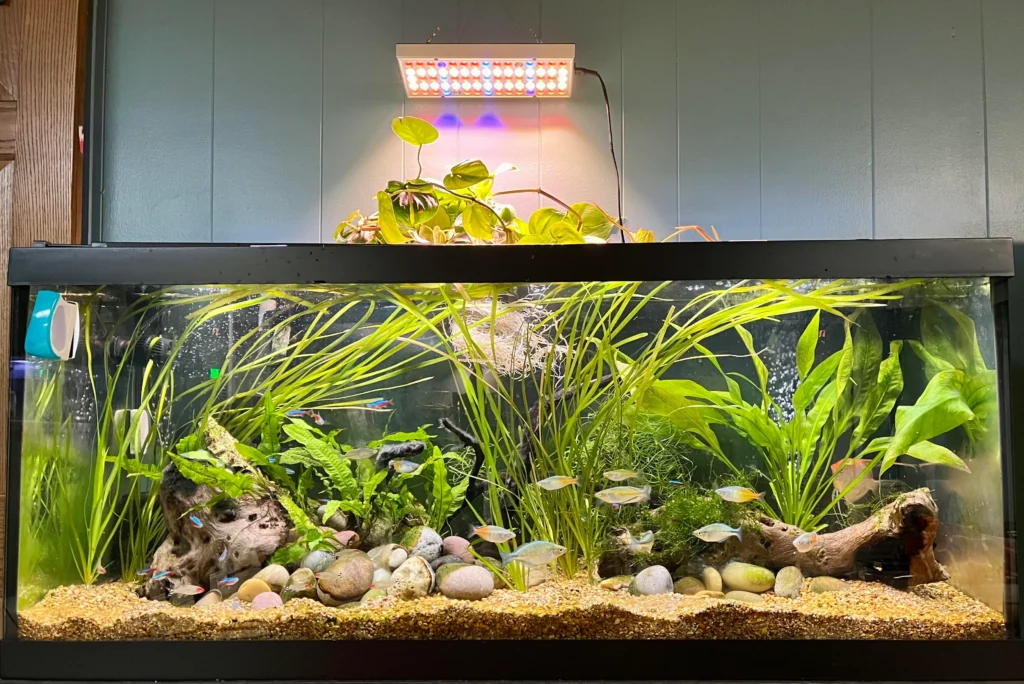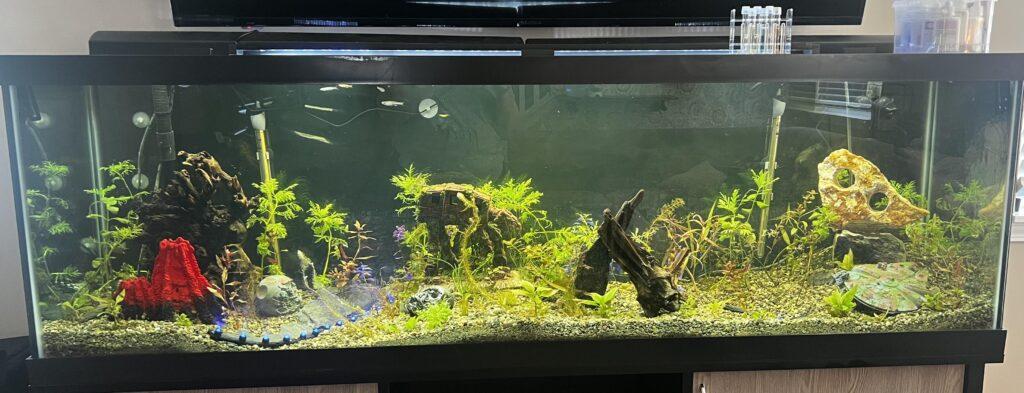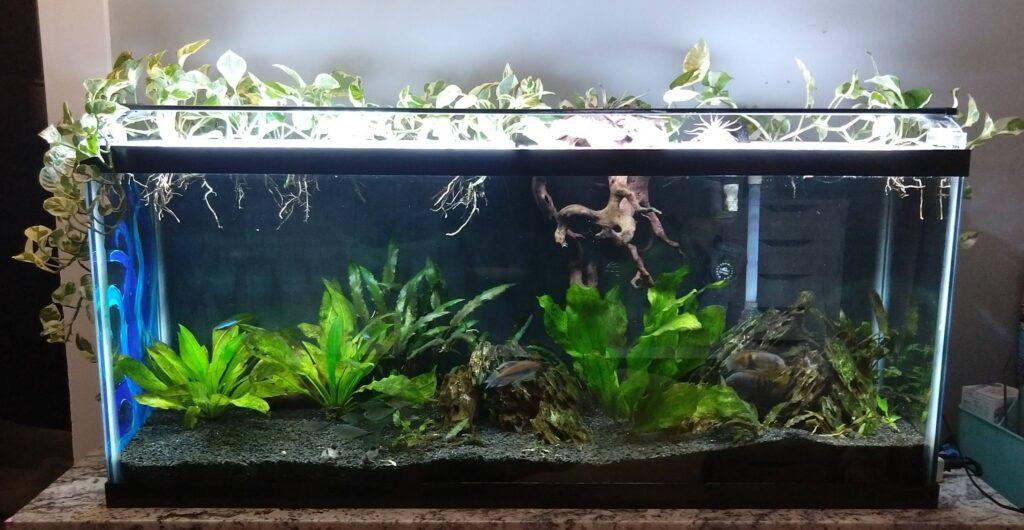
If you’re looking to enhance the aesthetics of your aquarium while also promoting a healthy aquatic environment, consider introducing the vibrant and resilient pothos plant.The versatile pothos plant, scientifically known as Epipremnum aureum or Devil’s Ivy, hails from Southeast Asia and is celebrated for its decorative appeal and low-maintenance nature.
With heart-shaped leaves ranging from green to yellow, this resilient plant thrives in low-light conditions and is well-suited for hanging baskets and cascading elements. Its adaptability extends to both soil and water, making it an ideal addition to aquariums, providing aesthetic charm and air-purifying benefits.
Whether you’re a beginner or seasoned aquarium enthusiast, the pothos plant brings a touch of natural elegance and functionality to indoor and aquatic spaces alike.In this guide, we’ll explore the steps to successfully incorporate pothos into your aquarium, providing your underwater realm with a touch of nature’s beauty and functionality.
7 Benefits of Using Pothos in Aquarium

1. Natural Filtration
Pothos plants play a crucial role in natural filtration within aquariums by absorbing nitrates and other harmful substances, promoting a healthier aquatic environment for fish and other inhabitants.
2. Oxygen Production
Through photosynthesis, pothos contributes to increased oxygen levels in the aquarium, benefitting the overall well-being of aquatic life and promoting a balanced ecosystem.
3. Algae Control
It helps control algae growth by competing for nutrients and blocking excessive light, reducing the likelihood of algae blooms and maintaining water clarity.
4. Aesthetic Appeal
With its lush and trailing vines, pothos adds a visually pleasing and natural touch to the aquarium, enhancing the overall aesthetics and creating a more appealing underwater landscape.
5. Easy Maintenance
This is a low-maintenance plant that requires minimal care. Its hardy nature makes it an excellent choice for aquarium enthusiasts, whether they are beginners or experienced hobbyists.
6. Versatility
Pothos can be grown both in soil and water, providing flexibility in aquarium design. Its adaptable nature allows for creative placement, catering to different tank layouts and preferences.
7. Reduced Stress for Fish
The presence of live plants, such as pothos, mimics a more natural habitat for fish, helping to reduce stress levels. This is especially beneficial for sensitive or easily stressed species in the aquarium.
6 Methods on How to Plant Pothos in Aquarium

1. The Floating Method
Planting pothos in an aquarium involves placing cuttings of the plant on the water’s surface. This can be achieved by securing the cuttings with a floatation device or a suction cup. As the pothos cuttings float, their roots grow and extend into the water, absorbing nutrients directly from the aquarium.
This not only adds a visually appealing element to the water surface but also contributes to natural filtration, as the pothos helps absorb and filter out nutrients, promoting a healthier aquatic environment for fish and other inhabitants
2. The Submerged Method
Pothos in an aquarium placing cuttings directly into the substrate at the bottom of the tank. In this method, the roots of the pothos cuttings are buried in the substrate, allowing the vines to trail along the aquarium floor or climb decorations.
This planting technique integrates pothos into the underwater environment, creating a natural and visually appealing arrangement. The submerged roots absorb nutrients from the substrate, contributing to the overall well-being of the aquarium and providing a unique aesthetic touch to the tank.
3. The Hanging Basket
Pothos is planted in the basket, allowing its vines to cascade down into the aquarium. This adds a vertical dimension to the tank, creating an eye-catching display with the vines draping into the water. It not only enhances the aesthetic appeal of the aquarium but also provides a unique way to incorporate pothos into the underwater environment, adding a touch of natural beauty to the tank.
4. The Decor Integration
The Aquarium Decor Integration method involves attaching pothos cuttings to aquarium decorations like driftwood or rocks using fishing line or aquarium-safe glue. This technique seamlessly incorporates pothos into the tank’s decor, creating a natural and integrated appearance.
As the plant attaches and grows on the decorations, it not only enhances the aesthetic appeal of the aquarium but also allows the pothos to thrive in a way that complements the overall design of the tank. It offers a creative and visually pleasing way to incorporate live plants into the aquarium environment.
5. Emersed Growth
Emersed Growth means placing pothos cuttings in a section of the aquarium where the stems are above the waterline, while the roots remain submerged. This method allows the plant to adapt to both aquatic and terrestrial conditions. The exposed stems above the water surface enable the pothos to grow in a semi-aquatic environment, providing an interesting and adaptable element to the aquarium setting.
6. External Filtration
In this method, pothos cuttings are planted in a dedicated section of the filter where their roots can absorb nutrients directly from the water. This not only adds a decorative touch but also provides additional filtration benefits to the aquarium. The pothos helps in removing impurities from the water, contributing to a healthier aquatic environment for the aquarium inhabitants.
Why Should You Plant Pothos in Aquarium?
Planting pothos in an aquarium offers numerous benefits that contribute to the overall health and aesthetic appeal of the aquatic environment. Firstly, pothos serves as a natural filtration system, absorbing nitrates and other harmful substances, thereby promoting water quality and creating a healthier habitat for fish and other aquatic life.
The plant’s ability to undergo photosynthesis enhances oxygen production, ensuring a well-balanced ecosystem. Pothos also plays a role in algae control by competing for nutrients and reducing excessive light, helping to maintain water clarity.
Beyond its functional advantages, pothos adds a visual dimension to the aquarium, with its lush, trailing vines creating a natural and pleasing underwater landscape. Its low-maintenance nature makes it suitable for aquarium enthusiasts of all levels, while its adaptability to both soil and water provides flexibility in tank design.
Conclusion
We’ve explored various methods for successfully planting pothos in an aquarium, each offering its unique benefits and considerations. Whether opting for the floating method, submerged growth, hanging baskets, decor integration, emersed growth, or external filtration, the key remains ensuring that the roots have access to the substrate for optimal growth.
Experimenting with different planting techniques, such as burying the root system with soil or peat moss for improved drainage, can further enhance the plant’s vitality. Additionally, considering the lighting needs of plants is crucial when selecting the appropriate planting container.
By keeping these factors in mind and implementing the tips provided, you can cultivate thriving aquatic plants in your aquarium, enriching the aesthetic beauty and ecological balance of your underwater realm. With patience and care, success in planting pothos in your aquarium is within reach!
Related article :How to Decorate a Sunroom with Plants
I’m Zaib Bilwal, and my journey into the world of home styling began in my school days, where I enjoyed rearranging my space. After graduating in 2015, I turned my passion for furniture refurbishing into a business. Today, it’s evolved into an interior design blog filled with inspiration and practical advice. My mission is simple, to make design accessible and enjoyable, offering you the tools and inspiration to create your dream home.